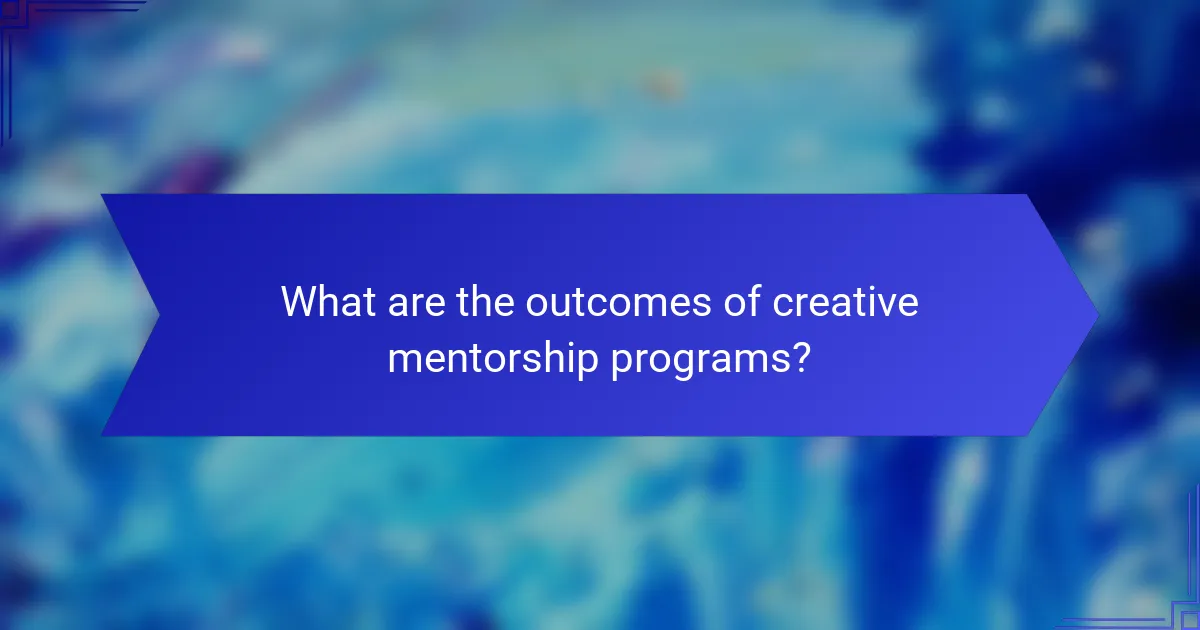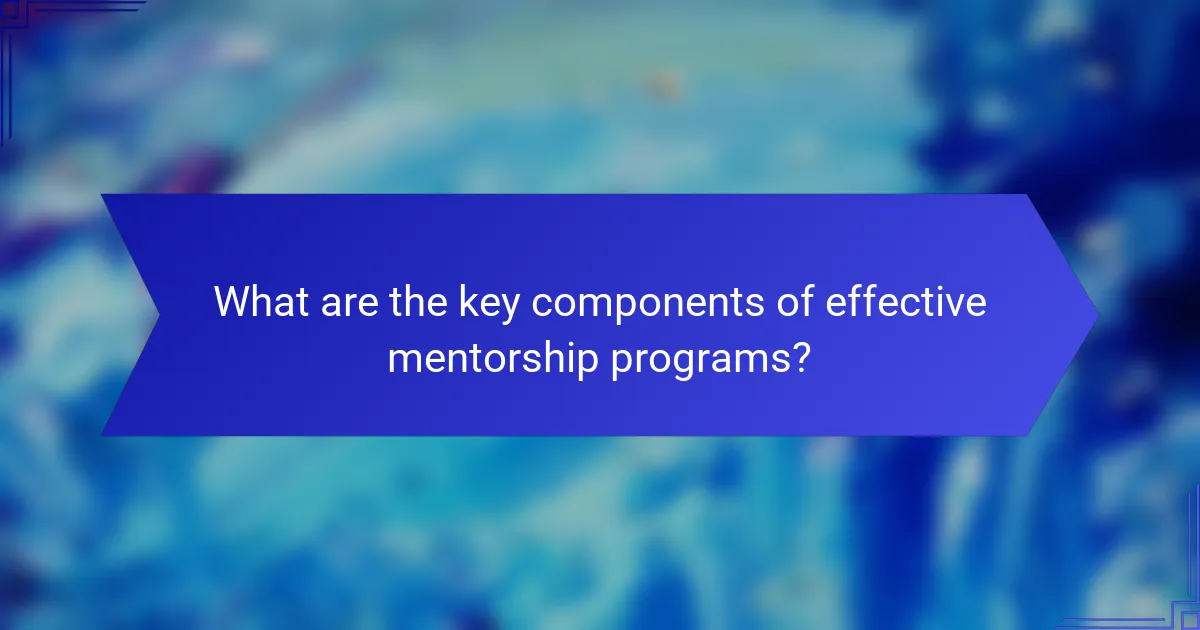Creative mentorship programs play a crucial role in fostering personal and professional growth among participants. By providing structured guidance, valuable resources, and opportunities for networking, these programs significantly enhance skills and career trajectories, particularly in competitive environments like New York. The outcomes often include increased confidence, improved project success, and a supportive community that nurtures creativity and innovation.

What are the outcomes of creative mentorship programs?
Creative mentorship programs yield several significant outcomes that enhance both personal and professional development. Participants often experience increased confidence, expanded networks, and improved success in their projects.
Increased creative confidence
One of the primary outcomes of creative mentorship programs is the boost in creative confidence among participants. Mentors provide guidance and constructive feedback, helping mentees to explore their ideas without fear of judgment.
This increased confidence can lead to a greater willingness to take risks in creative endeavors, ultimately resulting in more innovative work. Mentees often report feeling more empowered to express their unique perspectives and ideas.
Enhanced professional networks
Creative mentorship programs facilitate the expansion of professional networks for both mentors and mentees. By connecting with experienced professionals, mentees gain access to valuable contacts that can open doors to new opportunities.
Networking can include introductions to industry events, collaborations, and job opportunities. These connections often lead to long-term relationships that benefit both parties in their respective careers.
Improved project success rates
Participants in mentorship programs frequently see improved success rates in their creative projects. With the support and insights from mentors, mentees can refine their ideas and strategies, leading to higher quality outcomes.
Mentors can help identify potential pitfalls and provide solutions, which can significantly enhance the likelihood of project completion and success. This guidance often results in projects that are more aligned with industry standards and audience expectations.
Development of new skills
Creative mentorship programs are effective in fostering the development of new skills. Mentors often share their expertise and techniques, allowing mentees to learn practical skills that are directly applicable to their work.
This skill development can range from technical abilities, such as graphic design or writing, to soft skills like communication and collaboration. Mentees often leave the program with a more diverse skill set that enhances their employability.
Greater community engagement
Another important outcome of creative mentorship programs is increased community engagement. Mentors often encourage mentees to participate in community projects or initiatives, fostering a sense of responsibility and connection to their local environment.
Engagement can take many forms, including volunteering for local arts organizations or participating in community events. This involvement not only benefits the community but also enriches the mentee’s experience and perspective as a creative professional.

How do creative mentorship programs impact participants in New York?
Creative mentorship programs in New York significantly enhance participants’ skills, networks, and career trajectories. These programs provide valuable guidance and resources that help artists and creatives thrive in a competitive environment.
Boosted artistic portfolios
Participants in mentorship programs often see a marked improvement in their artistic portfolios. Mentors provide constructive feedback and insights that help mentees refine their work and showcase their unique styles effectively.
Additionally, many programs encourage the inclusion of collaborative projects, which can diversify a portfolio. This variety can attract potential clients or employers looking for versatile artists.
Access to industry events
Creative mentorship programs frequently offer participants exclusive access to industry events, such as exhibitions, workshops, and networking gatherings. These events are crucial for building connections and staying informed about trends and opportunities in the arts sector.
Attending such events can lead to potential collaborations and job offers, significantly enhancing a participant’s visibility in the New York arts community.
Collaboration opportunities with local artists
Mentorship programs foster collaboration between emerging artists and established professionals, creating a vibrant creative ecosystem. These partnerships often lead to innovative projects that benefit all involved.
By working alongside local artists, participants can gain new perspectives and techniques, enriching their own artistic practice. This collaborative spirit is essential in a city known for its diverse artistic landscape.

What are the key components of effective mentorship programs?
Effective mentorship programs hinge on several key components that foster growth and development. These elements include structured goal-setting, regular feedback sessions, and tailored mentorship approaches, all of which contribute to a productive mentoring relationship.
Structured goal-setting
Structured goal-setting is essential for guiding the mentorship process. It involves defining clear, measurable objectives that both the mentor and mentee agree upon at the outset. This clarity helps keep the mentorship focused and ensures that both parties are aligned in their expectations.
To implement effective goal-setting, mentors and mentees should use the SMART criteria: Specific, Measurable, Achievable, Relevant, and Time-bound. For instance, instead of a vague goal like “improve skills,” a SMART goal would be “complete a project using new software by the end of the quarter.” This specificity allows for better tracking of progress.
Regular feedback sessions
Regular feedback sessions are crucial for maintaining momentum in a mentorship program. These sessions provide opportunities for mentors to offer constructive criticism and for mentees to reflect on their progress. Frequent check-ins can help identify challenges early and adjust goals as necessary.
Mentors should aim to schedule feedback sessions at consistent intervals, such as bi-weekly or monthly. During these sessions, it’s beneficial to discuss what is working well and what needs improvement. This ongoing dialogue fosters a supportive environment and encourages continuous learning.
Tailored mentorship approaches
Tailored mentorship approaches recognize that each mentee has unique needs and learning styles. Effective mentors adapt their strategies to fit the individual, which can enhance engagement and effectiveness. This personalization can involve varying communication styles, resources, and methods of instruction.
For example, some mentees may thrive with hands-on projects, while others might prefer theoretical discussions. Mentors should assess their mentee’s preferences and adjust their approach accordingly. This flexibility not only improves the learning experience but also strengthens the mentor-mentee relationship.

How can organizations measure the success of their mentorship initiatives?
Organizations can measure the success of their mentorship initiatives through various methods, including participant feedback, tracking career advancements, and evaluating project outcomes. These approaches provide insights into the effectiveness of mentorship programs and help identify areas for improvement.
Participant surveys and feedback
Collecting participant surveys and feedback is a direct way to gauge the success of mentorship initiatives. Surveys can include questions about satisfaction levels, perceived value, and specific skills gained through the program.
To ensure comprehensive feedback, consider using a mix of quantitative ratings and qualitative comments. Aim for a response rate of at least 70% to obtain reliable data, and analyze trends over time to assess improvements or declines in participant experiences.
Tracking career advancements
Monitoring career advancements of mentees can provide tangible evidence of mentorship success. This can include promotions, salary increases, or new job opportunities that arise after participating in the program.
Establish a baseline by documenting the career status of participants before and after mentorship. Aim to track these metrics over a period of one to two years to see meaningful changes, and compare these advancements with non-participants to assess the program’s impact.
Evaluating project outcomes
Evaluating project outcomes is crucial to understanding the effectiveness of mentorship initiatives. This involves assessing the success of projects that mentees have worked on during their mentorship, including quality, timeliness, and overall impact.
Set clear, measurable goals for projects and review them post-completion. Consider using a scoring system to evaluate project success based on criteria such as innovation, collaboration, and results achieved. This can help link mentorship directly to project performance and organizational goals.

What are the best practices for implementing creative mentorship programs?
Effective creative mentorship programs hinge on a few best practices that ensure both mentors and mentees achieve their goals. By focusing on clear objectives and effective matching, organizations can foster productive relationships that enhance creativity and professional growth.
Defining clear objectives
Establishing clear objectives is crucial for the success of creative mentorship programs. These objectives should align with both the organization’s goals and the individual aspirations of the participants. For instance, a program might aim to enhance specific skills, such as design thinking or project management, or foster innovation in product development.
To define these objectives, consider conducting surveys or interviews with potential participants to understand their needs and expectations. This feedback can help shape the program’s focus, ensuring that it addresses relevant challenges and opportunities within the creative field.
Matching mentors and mentees effectively
Effective matching of mentors and mentees is essential for a successful mentorship experience. Consider factors such as professional background, creative expertise, and personal interests when pairing participants. A well-matched relationship can lead to more meaningful interactions and better outcomes.
Utilize a structured matching process that includes assessments or questionnaires to gauge compatibility. For example, if a mentee seeks guidance in digital marketing, pairing them with a mentor who has extensive experience in that area can enhance the learning experience. Regular check-ins can also help ensure that the match remains beneficial over time.